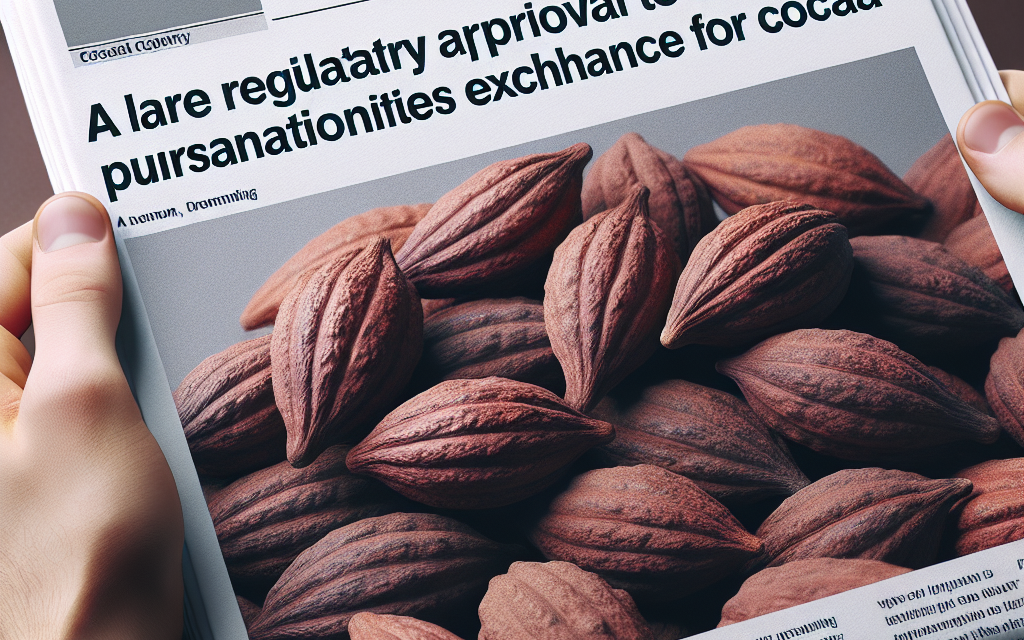“Hershey Seeks CFTC Green Light to Expand Cocoa Purchases Beyond ICE Limits.”
Introduction
Hershey has reportedly sought approval from the Commodity Futures Trading Commission (CFTC) to exceed the purchase limits set by the Intercontinental Exchange (ICE) for cocoa. This move comes amid rising demand for cocoa products and potential supply chain challenges. By requesting this exemption, Hershey aims to secure a stable supply of cocoa to meet its production needs and maintain its market position in the competitive chocolate industry. The decision by the CFTC could have significant implications for Hershey’s operations and the broader cocoa market.
Hershey’s Strategic Move: Seeking CFTC Approval
In a significant development within the commodities market, Hershey, the renowned chocolate manufacturer, has reportedly sought approval from the Commodity Futures Trading Commission (CFTC) to exceed the purchase limits imposed by the Intercontinental Exchange (ICE) on cocoa. This strategic move underscores Hershey’s commitment to securing its supply chain amid fluctuating market conditions and rising demand for cocoa products. As the global appetite for chocolate continues to grow, Hershey’s request highlights the challenges faced by major players in the industry, particularly in navigating regulatory frameworks while ensuring a stable supply of raw materials.
The request to the CFTC is particularly noteworthy given the current dynamics of the cocoa market, which has been characterized by volatility due to various factors, including climate change, geopolitical tensions, and supply chain disruptions. By seeking to exceed the ICE cocoa purchase limits, Hershey aims to bolster its procurement strategy, allowing the company to better manage its inventory and mitigate risks associated with price fluctuations. This proactive approach not only reflects Hershey’s understanding of market trends but also its desire to maintain a competitive edge in an increasingly crowded marketplace.
Moreover, Hershey’s decision to pursue this approval can be seen as a response to the growing consumer demand for chocolate products, which has surged in recent years. As consumers become more discerning about the quality and sourcing of their food, companies like Hershey are compelled to adapt their strategies to meet these expectations. By securing a more reliable cocoa supply, Hershey can ensure that it continues to deliver high-quality products that resonate with its customer base. This alignment with consumer preferences is crucial, as it not only enhances brand loyalty but also positions Hershey favorably against its competitors.
In addition to addressing supply chain concerns, Hershey’s request for CFTC approval also reflects broader trends within the food and beverage industry. As companies increasingly recognize the importance of sustainability and ethical sourcing, Hershey’s move may also be interpreted as an effort to enhance its corporate social responsibility initiatives. By ensuring a stable supply of cocoa, Hershey can better support sustainable farming practices and contribute to the livelihoods of cocoa farmers, thereby fostering a more resilient supply chain.
Furthermore, the implications of Hershey’s request extend beyond the company itself, potentially influencing market dynamics and regulatory discussions within the cocoa industry. If approved, Hershey’s ability to exceed purchase limits could set a precedent for other companies seeking similar exemptions, thereby reshaping the landscape of cocoa procurement. This could lead to increased competition among chocolate manufacturers, prompting them to reevaluate their own strategies in light of Hershey’s actions.
In conclusion, Hershey’s request for CFTC approval to exceed ICE cocoa purchase limits represents a strategic maneuver aimed at securing a stable supply of cocoa in an unpredictable market. By taking this step, Hershey not only addresses immediate supply chain challenges but also positions itself to meet the evolving demands of consumers. As the company navigates the complexities of regulatory frameworks and market dynamics, its actions may have far-reaching implications for the cocoa industry as a whole. Ultimately, Hershey’s proactive approach underscores the importance of adaptability and foresight in an ever-changing business environment, ensuring that it remains a leader in the chocolate market for years to come.
Impact of ICE Cocoa Purchase Limits on Hershey
The recent request by Hershey to the Commodity Futures Trading Commission (CFTC) for approval to exceed the Intercontinental Exchange (ICE) cocoa purchase limits has sparked significant discussion regarding the implications of these purchase limits on the company’s operations and the broader cocoa market. The ICE cocoa purchase limits are designed to prevent excessive speculation and ensure market stability, but they can also pose challenges for major players like Hershey, which relies heavily on cocoa as a key ingredient in its products. As a leading chocolate manufacturer, Hershey’s ability to secure a stable supply of cocoa is crucial for maintaining production levels and meeting consumer demand.
The constraints imposed by the ICE cocoa purchase limits can create a precarious situation for Hershey, particularly in times of fluctuating cocoa prices. When prices rise, the company may find itself unable to purchase the necessary quantities of cocoa to fulfill its production needs, potentially leading to supply shortages. This situation can have a cascading effect, impacting not only Hershey’s ability to produce its products but also its competitive position in the market. If Hershey cannot secure enough cocoa, it may be forced to raise prices, which could alienate consumers and lead to a loss of market share to competitors who can navigate the purchasing limits more effectively.
Moreover, the purchase limits can hinder Hershey’s ability to hedge against price volatility. Hedging is a common practice in commodity markets, allowing companies to lock in prices and protect themselves from sudden market shifts. However, when purchase limits restrict the volume of cocoa that can be bought, Hershey may find it challenging to implement effective hedging strategies. This limitation can expose the company to greater financial risk, as it may be unable to mitigate the impact of rising cocoa prices on its profit margins. Consequently, the request for CFTC approval to exceed these limits reflects Hershey’s recognition of the need for greater flexibility in its cocoa procurement strategy.
In addition to the immediate operational challenges, the ICE cocoa purchase limits can also influence Hershey’s long-term strategic planning. The company must consider how these limits affect its sourcing strategies and relationships with cocoa suppliers. If Hershey is unable to secure sufficient cocoa through traditional purchasing methods, it may need to explore alternative sourcing options, such as direct partnerships with cocoa farmers or investments in sustainable cocoa production initiatives. These strategies could help mitigate the risks associated with purchase limits while also aligning with growing consumer demand for ethically sourced products.
Furthermore, the broader implications of Hershey’s request for CFTC approval extend beyond the company itself. If granted, this approval could set a precedent for other companies in the cocoa industry, potentially leading to a reevaluation of the existing purchase limits. Such a shift could alter the dynamics of the cocoa market, affecting pricing, supply chains, and competition among chocolate manufacturers. As Hershey navigates this complex landscape, it must balance its immediate needs with the potential long-term consequences of its actions.
In conclusion, the impact of ICE cocoa purchase limits on Hershey is multifaceted, influencing everything from operational efficiency to strategic planning. The company’s request for CFTC approval to exceed these limits underscores the challenges posed by regulatory constraints in a volatile market. As Hershey seeks to secure its position in the cocoa supply chain, it must carefully consider the implications of its procurement strategies, not only for its own operations but also for the broader cocoa industry.
Implications of CFTC Approval for Cocoa Market
The recent request by Hershey to the Commodity Futures Trading Commission (CFTC) for approval to exceed the Intercontinental Exchange (ICE) cocoa purchase limits has significant implications for the cocoa market. This development comes at a time when the global cocoa industry is grappling with various challenges, including fluctuating prices, supply chain disruptions, and increasing demand for chocolate products. If the CFTC grants Hershey’s request, it could set a precedent that may alter the dynamics of cocoa trading and influence market behavior.
To begin with, Hershey’s request highlights the growing demand for cocoa, particularly in the context of rising consumer interest in chocolate and confectionery products. As one of the largest chocolate manufacturers in the United States, Hershey’s ability to secure a stable supply of cocoa is crucial for maintaining its production levels and meeting consumer expectations. By seeking to exceed the purchase limits, Hershey aims to ensure that it can procure sufficient quantities of cocoa to support its operations, especially during periods of market volatility. This move underscores the importance of strategic sourcing in an industry where supply constraints can lead to significant price increases.
Moreover, if the CFTC approves Hershey’s request, it could lead to increased competition among cocoa buyers. Other major players in the chocolate and confectionery sector may feel compelled to follow suit, seeking similar approvals to secure their own supply chains. This potential influx of demand could drive cocoa prices higher, impacting not only manufacturers but also consumers who may face increased prices for chocolate products. Consequently, the approval could create a ripple effect throughout the cocoa supply chain, affecting farmers, traders, and retailers alike.
In addition to price implications, Hershey’s request raises questions about market regulation and the role of the CFTC in overseeing commodity trading. The ICE cocoa purchase limits are designed to prevent excessive speculation and ensure a level playing field for all market participants. If Hershey is granted an exemption, it may prompt discussions about the fairness of such regulations and whether they adequately protect smaller players in the market. This situation could lead to calls for a reevaluation of existing limits and a broader conversation about how to balance the needs of large corporations with those of smaller producers and traders.
Furthermore, the approval could have implications for sustainability initiatives within the cocoa industry. As demand for cocoa increases, there is a growing emphasis on sustainable sourcing practices that prioritize environmental and social responsibility. Hershey’s ability to secure larger quantities of cocoa may influence its sourcing strategies, potentially impacting its commitments to sustainability. If larger purchases lead to increased pressure on cocoa-producing regions, it could exacerbate issues such as deforestation and labor exploitation, which are already significant concerns in the industry.
In conclusion, Hershey’s request for CFTC approval to exceed ICE cocoa purchase limits carries far-reaching implications for the cocoa market. From potential price increases and heightened competition to regulatory considerations and sustainability challenges, the outcome of this request could reshape the landscape of cocoa trading. As stakeholders in the industry closely monitor this situation, it is clear that the decisions made by regulatory bodies will play a crucial role in determining the future of cocoa supply chains and the broader chocolate market. The unfolding developments will undoubtedly warrant attention from all corners of the cocoa industry, as they navigate the complexities of a rapidly evolving market.
Hershey’s Cocoa Supply Chain: Challenges and Opportunities
Hershey’s cocoa supply chain is a complex network that faces numerous challenges while also presenting significant opportunities for growth and innovation. As one of the largest chocolate manufacturers in the world, Hershey relies heavily on a steady and sustainable supply of cocoa to meet consumer demand. However, the cocoa market is fraught with volatility, influenced by factors such as climate change, political instability in producing countries, and fluctuating prices. These challenges necessitate a strategic approach to sourcing cocoa, which has become increasingly critical for Hershey as it seeks to maintain its competitive edge.
One of the primary challenges in Hershey’s cocoa supply chain is the impact of climate change on cocoa production. Cocoa trees are sensitive to temperature and rainfall variations, and as global temperatures rise, the regions suitable for cocoa cultivation are shifting. This not only threatens the supply of cocoa but also affects the quality of the beans. Hershey has recognized the importance of addressing these environmental concerns and has taken steps to invest in sustainable farming practices. By collaborating with farmers and agricultural organizations, Hershey aims to promote climate-resilient cocoa farming techniques that can help mitigate the adverse effects of climate change.
In addition to environmental challenges, Hershey faces socio-economic issues within its cocoa supply chain. Many cocoa farmers operate in regions where poverty is prevalent, leading to labor issues, including child labor and inadequate wages. Hershey has made commitments to improve the livelihoods of cocoa farmers through its Cocoa For Good program, which focuses on enhancing farmer income, promoting education, and ensuring sustainable farming practices. By investing in the communities where cocoa is grown, Hershey not only secures its supply chain but also contributes to the overall well-being of the farmers and their families.
Moreover, the cocoa market is characterized by price volatility, which can significantly impact Hershey’s operational costs. The company has sought to navigate this uncertainty by diversifying its sourcing strategies and exploring alternative supply channels. For instance, Hershey has engaged in long-term contracts with cocoa suppliers to stabilize prices and ensure a consistent supply. This proactive approach allows Hershey to manage risks associated with price fluctuations while also fostering stronger relationships with its suppliers.
As Hershey navigates these challenges, it also recognizes the opportunities that lie ahead. The growing consumer demand for ethically sourced and sustainable products presents a unique chance for Hershey to differentiate itself in the marketplace. By emphasizing its commitment to sustainability and ethical sourcing, Hershey can appeal to a more conscious consumer base that prioritizes social responsibility. This alignment with consumer values not only enhances brand loyalty but also positions Hershey as a leader in the industry.
Furthermore, advancements in technology offer Hershey the potential to optimize its cocoa supply chain. Innovations such as blockchain can enhance traceability, allowing Hershey to monitor the journey of cocoa from farm to factory. This transparency not only builds consumer trust but also enables Hershey to ensure compliance with ethical sourcing standards. By leveraging technology, Hershey can streamline its operations, reduce waste, and improve overall efficiency.
In conclusion, Hershey’s cocoa supply chain is a dynamic landscape filled with both challenges and opportunities. By addressing environmental and socio-economic issues while embracing technological advancements, Hershey is well-positioned to navigate the complexities of the cocoa market. As the company continues to adapt and innovate, it can ensure a sustainable and resilient supply chain that meets the demands of consumers and supports the communities that produce its essential ingredient.
Regulatory Landscape: CFTC’s Role in Commodity Markets
The regulatory landscape governing commodity markets is complex and multifaceted, with various agencies playing critical roles in ensuring fair practices and market stability. Among these agencies, the Commodity Futures Trading Commission (CFTC) stands out as a pivotal entity responsible for overseeing the derivatives markets, including futures and options contracts. The CFTC’s primary mission is to protect market participants from fraud, manipulation, and abusive practices, while also fostering open, competitive, and financially sound markets. This regulatory oversight is particularly significant in the context of agricultural commodities, where price volatility can have profound implications for producers, consumers, and traders alike.
In recent developments, Hershey, a prominent player in the chocolate and confectionery industry, has sought approval from the CFTC to exceed the purchase limits set by the Intercontinental Exchange (ICE) for cocoa. This request highlights the intricate relationship between regulatory frameworks and the operational strategies of major corporations within commodity markets. The ICE, as a leading global marketplace for trading cocoa and other agricultural products, imposes position limits to prevent excessive speculation and ensure that no single entity can dominate the market. These limits are designed to promote liquidity and protect the interests of smaller market participants, thereby contributing to a balanced trading environment.
Hershey’s request to exceed these limits raises important questions about the balance between corporate strategy and regulatory compliance. As a significant buyer of cocoa, Hershey’s operations are directly influenced by fluctuations in cocoa prices, which can be affected by various factors, including weather conditions, geopolitical events, and changes in consumer demand. By seeking to increase its purchasing capacity, Hershey aims to secure a more stable supply of cocoa, thereby mitigating risks associated with price volatility. However, this move also necessitates careful consideration of the potential implications for market dynamics and the broader regulatory framework.
The CFTC’s role in this context is crucial, as it must evaluate Hershey’s request within the framework of existing regulations and market conditions. The agency will likely assess the potential impact of granting such an exemption on market integrity and competition. This evaluation process underscores the importance of regulatory oversight in maintaining a level playing field for all market participants. Furthermore, it highlights the ongoing dialogue between regulators and industry stakeholders, as both parties navigate the complexities of commodity trading in an ever-evolving market landscape.
As the CFTC deliberates on Hershey’s request, it is essential to recognize the broader implications of such regulatory decisions. The outcome could set a precedent for how similar requests are handled in the future, influencing not only Hershey’s operations but also the strategies of other companies within the cocoa and broader agricultural markets. Additionally, it may prompt a reevaluation of existing position limits and their effectiveness in achieving the CFTC’s objectives of market integrity and participant protection.
In conclusion, the intersection of corporate strategy and regulatory oversight is a defining feature of commodity markets. Hershey’s request for CFTC approval to exceed ICE cocoa purchase limits serves as a case study in the complexities of navigating these waters. As the CFTC weighs the implications of this request, it will be essential to consider the potential impacts on market dynamics, competition, and the overall health of the cocoa market. Ultimately, the decisions made in this context will resonate beyond Hershey, shaping the regulatory landscape for commodity markets in the years to come.
Market Reactions to Hershey’s Approval Request
In recent developments, Hershey has formally requested approval from the Commodity Futures Trading Commission (CFTC) to exceed the purchase limits set by the Intercontinental Exchange (ICE) for cocoa. This request has sparked a variety of reactions within the market, reflecting the complexities of commodity trading and the implications of such a move for both Hershey and the broader cocoa industry. As Hershey seeks to secure its supply chain amid fluctuating cocoa prices and increasing demand for chocolate products, market participants are closely monitoring the potential outcomes of this request.
The immediate reaction from investors and analysts has been one of cautious optimism. Many view Hershey’s request as a strategic maneuver to ensure a stable supply of cocoa, which is essential for its production processes. Given the volatility in cocoa prices, driven by factors such as climate change, political instability in cocoa-producing regions, and shifts in consumer preferences, Hershey’s proactive approach may be seen as a necessary step to mitigate risks associated with supply shortages. Consequently, some market analysts have suggested that if the CFTC grants this approval, it could lead to a more favorable pricing environment for Hershey, allowing the company to maintain its competitive edge in the chocolate market.
However, not all market reactions have been positive. Critics argue that allowing Hershey to exceed the purchase limits could set a concerning precedent within the commodity markets. They express concerns that such a move might lead to increased market concentration, potentially disadvantaging smaller cocoa producers and traders who may struggle to compete against a major player like Hershey. This perspective highlights the delicate balance that regulatory bodies must maintain between facilitating corporate strategies and ensuring fair competition within the market. As a result, the CFTC’s decision will likely be scrutinized not only for its immediate impact on Hershey but also for its broader implications for the cocoa industry.
Moreover, the request has prompted discussions about the ethical dimensions of cocoa sourcing. Hershey has made commitments to sustainable sourcing practices, and any move to increase its cocoa purchases must align with these principles. Stakeholders, including consumers and advocacy groups, are increasingly demanding transparency and accountability in the supply chain. Therefore, if Hershey is granted approval, it will be essential for the company to communicate how it plans to uphold its sustainability commitments while expanding its cocoa procurement. This aspect of the conversation is particularly relevant in light of ongoing concerns about child labor and environmental degradation in cocoa-producing regions.
In addition to these considerations, market analysts are also evaluating the potential impact on cocoa futures. If Hershey’s request is approved, it could lead to increased buying pressure in the cocoa market, which may drive prices higher in the short term. Conversely, if the CFTC denies the request, it could result in a temporary stabilization of cocoa prices as market participants adjust their expectations. The interplay between Hershey’s strategic decisions and market dynamics underscores the intricate nature of commodity trading, where regulatory actions can have far-reaching consequences.
In conclusion, Hershey’s request for CFTC approval to exceed ICE cocoa purchase limits has elicited a range of reactions from market participants. While some view it as a necessary step for securing supply and maintaining competitiveness, others raise concerns about market fairness and ethical sourcing. As the situation unfolds, the implications of this request will likely resonate throughout the cocoa industry, influencing not only pricing dynamics but also the broader conversation about sustainability and corporate responsibility in commodity markets.
Future of Cocoa Pricing: Insights from Hershey’s Actions
In recent developments within the cocoa market, Hershey has made headlines by requesting approval from the Commodity Futures Trading Commission (CFTC) to exceed the purchase limits set by the Intercontinental Exchange (ICE) for cocoa. This request not only highlights Hershey’s strategic positioning in the cocoa supply chain but also raises important questions about the future of cocoa pricing and market dynamics. As one of the largest chocolate manufacturers in the world, Hershey’s actions can significantly influence cocoa prices, which have been subject to volatility due to various factors, including climate change, geopolitical tensions, and supply chain disruptions.
Hershey’s request to exceed the ICE cocoa purchase limits indicates a proactive approach to securing its cocoa supply amid rising concerns over availability and pricing. The company’s move can be interpreted as a response to the increasing demand for chocolate products, which has surged in recent years, particularly in emerging markets. As consumer preferences shift towards premium and sustainable chocolate options, manufacturers like Hershey are compelled to ensure a stable supply of high-quality cocoa. By seeking to exceed purchase limits, Hershey aims to mitigate risks associated with price fluctuations and potential shortages, thereby safeguarding its production capabilities and market share.
Moreover, this request reflects broader trends in the cocoa market, where supply constraints have become more pronounced. Factors such as climate change have adversely affected cocoa production in key growing regions, particularly in West Africa, which supplies a significant portion of the world’s cocoa. Erratic weather patterns, including droughts and excessive rainfall, have led to reduced yields, prompting concerns about future supply. In this context, Hershey’s actions can be seen as a strategic maneuver to secure cocoa at potentially lower prices before further disruptions occur. By locking in supply, Hershey not only aims to stabilize its production costs but also to maintain competitive pricing for its products.
Additionally, Hershey’s request may have implications for cocoa pricing on a broader scale. If the CFTC grants approval, it could set a precedent for other major players in the industry to follow suit, potentially leading to increased purchasing activity that could drive cocoa prices higher. This scenario underscores the interconnectedness of market participants and the ripple effects that decisions made by large corporations can have on commodity pricing. As Hershey seeks to navigate these complexities, it is essential to consider how its actions might influence market sentiment and investor behavior in the cocoa sector.
Furthermore, Hershey’s request highlights the importance of regulatory frameworks in commodity markets. The CFTC’s role in overseeing trading practices and ensuring market integrity is crucial, especially in times of heightened volatility. As Hershey and other companies seek to adapt to changing market conditions, the regulatory environment will play a pivotal role in shaping their strategies. The balance between ensuring fair competition and allowing companies the flexibility to secure their supply chains will be a critical consideration for regulators moving forward.
In conclusion, Hershey’s request for CFTC approval to exceed ICE cocoa purchase limits is a significant development that reflects the complexities of the cocoa market and the challenges faced by major chocolate manufacturers. As the company navigates supply constraints and rising demand, its actions will undoubtedly influence cocoa pricing and market dynamics in the coming years. The interplay between corporate strategies, regulatory oversight, and market conditions will continue to shape the future of cocoa pricing, making it a critical area for stakeholders to monitor closely.
Q&A
1. **What is Hershey requesting from the CFTC?**
Hershey is requesting approval from the Commodity Futures Trading Commission (CFTC) to exceed the purchase limits for cocoa set by the Intercontinental Exchange (ICE).
2. **Why does Hershey want to exceed these limits?**
Hershey aims to secure a stable supply of cocoa to meet its production needs and manage costs amid fluctuating market conditions.
3. **What are the current purchase limits set by ICE?**
The specific purchase limits set by ICE can vary, but they are designed to prevent market manipulation and ensure fair trading practices.
4. **What could be the implications of Hershey’s request?**
If approved, Hershey could potentially increase its cocoa purchases, which may impact cocoa prices and availability in the market.
5. **How might this affect Hershey’s operations?**
Gaining approval could allow Hershey to better manage its supply chain and production costs, ensuring a consistent flow of cocoa for its products.
6. **What is the CFTC’s role in this situation?**
The CFTC regulates commodity markets and ensures that trading practices are fair and transparent, including overseeing purchase limits.
7. **What are the potential market reactions to this news?**
Market reactions could include fluctuations in cocoa prices, increased scrutiny from other market participants, and potential changes in trading strategies among competitors.
Conclusion
Hershey’s request for CFTC approval to exceed ICE cocoa purchase limits indicates the company’s strategic move to secure a stable supply of cocoa amid fluctuating market conditions. This action reflects Hershey’s commitment to maintaining its production capabilities and addressing potential supply chain challenges, ultimately aiming to ensure consistent product availability and pricing stability for its consumers.





